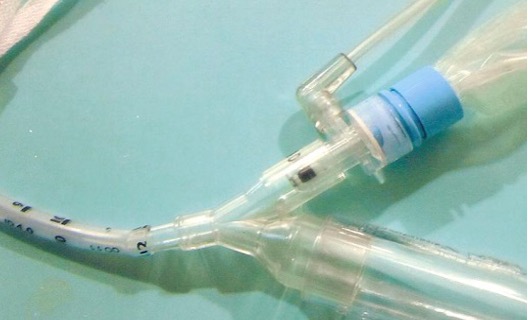INTRODUCTION
- This guideline:
- relates only to a closed suction catheter system in ventilated babies, which is non-aerosol generating
- describes a standard safe approach, but it may be necessary for an adapted method to be employed (see If ETT clearance proves difficult with standard approach)
- Goal of ETT suctioning should be to maximise the amount of secretions removed with minimal adverse effects
- Should not be a routine procedure, but in response to indications
INDICATIONS
- To maintain airway patency
- To remove respiratory secretions or aspirated fluid from within the ETT
- To optimise oxygenation and ventilation in an intubated baby
- To obtain secretions for culture analysis
EQUIPMENT
- In line/closed circuit catheter
- catheter size <0.5 diameter of ETT
- PPE as per local guidelines for non-aerosol generating procedures
- Sodium chloride 0.9%
- 1 mL syringe
PROCEDURE
- Do not attempt to carry out this procedure unless trained in the use of endotracheal closed suction catheter system
Preparation
-
Wash hands and put on PPE
-
Auscultate chest before suctioning
-
Ensure full monitoring of heart rate and SpO2 in place
-
Ensure baby is adequately oxygenated; consider increasing FiO2 by up to 0.1 before procedure, e.g. if baby receiving FiO2 of 0.3 (or 30% oxygen), increase oxygen delivery to up to FiO2 0.4 (or 40% oxygen)
-
if possible, use dedicated suction procedure (e.g. special procedures on Draegar VN500) which automatically enriches oxygen during suction
-
-
Ensure baby positioned appropriately for secretion clearance and stress reduction
-
Ensure closed suction device is unlocked
-
Check suction pressure – maximum 13 kPa. Use lowest pressure that effectively clears secretions
-
Check ETT placement by confirming measurement at the lips is as documented
Measuring catheter advancement
Method 1 (compatible with Halyard Health brand of closed suction catheters)
- Note the printed number on the cut ETT
- Add 5 cm to this to give the total distance of suction catheter advancement
- Stabilise the Y adaptor with one hand and advance catheter until calculated length is visible in irrigation port window.
- Catheter tip will be within 0.5–1 cm of the end of the ETT
- Note the nearest coloured band to the irrigation port window. Coloured bands allow for easy visualisation on subsequent suction procedures

Method 2
- Stabilise the Y adaptor with one hand
- Advance catheter until printed depth numbers on catheter align with the same numbers printed on the ETT
- Catheter tip will be within 0.5–1 cm of the end of the ETT
Performing suctioning
- Ensure suction catheter correctly advanced using either methods 1 or 2 (above)
- Depress thumb control valve and hold while withdrawing catheter slowly
- When tip of suction catheter reaches dome, release thumb control valve and stop withdrawing
- Procedure should take ≤10 sec and the duration of negative pressure should be ≤5 sec
- Repeat procedure if necessary
- Do not use sodium chloride 0.9% instillation routinely. Sodium chloride 0.9% ≤0.5 mL may be instilled before suctioning if secretions are thick and tenacious and cannot be extracted by suctioning alone
- After each suctioning episode ensure the closed circuit is flushed with sodium chloride 0.9% according to manufacturer’s instructions
If ETT clearance proves difficult with standard approach
- Advancement of the catheter to 0.5 cm below the ETT tip may be effective
- An experienced clinician should determine if this is appropriate
- See https://vimeo.com/428618217/9cc5803f88 for demonstration of this technique
DOCUMENTATION
- Record procedure in nursing documentation, noting distance tube was passed and colour of band on catheter tube closest to this measured distance
AFTERCARE
Equipment
- Leave thumb valve in locked position when not in use to prevent inadvertent activation
- Leave catheter tip in dome between use
- Device is single use only and replace every 24 hr as per manufacturer’s guidance
Monitoring
-
Ensure monitoring of heart rate and SpO2 continues after procedure
-
Auscultate baby’s chest after procedure and document any changes observed
-
If FiO2 was adjusted before procedure, return to original settings, or ensure baby’s target FiO2 is maintained
Reporting adverse events
- Report adverse incidents using local risk management procedure
COMPLICATIONS
-
Hypoxaemia
-
Atelectasis
-
Bradycardia
-
Tachycardia
-
Blood pressure fluctuations
-
Decreased tidal volume
-
Airway mucosal trauma
-
Dislodgement of ETT
-
Extubation
-
Pneumothorax
-
Pneumomediastinum
-
Bacteraemia
-
Pneumonia
-
Fluctuations in intracranial pressure and cerebral blood flow velocity
FURTHER INFORMATION
- Further details on ETT closed suction can be found in the manufacturer’s guidance